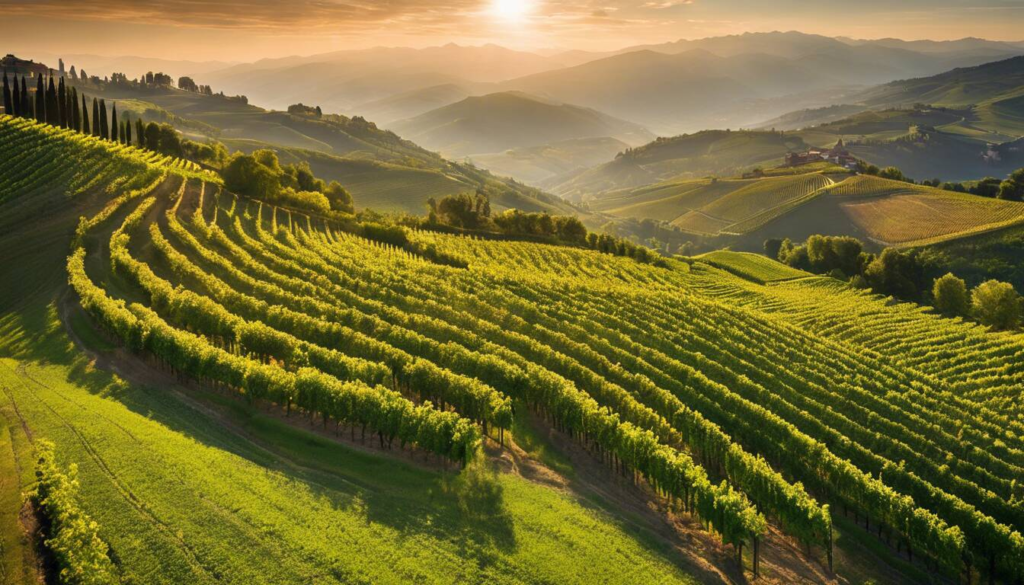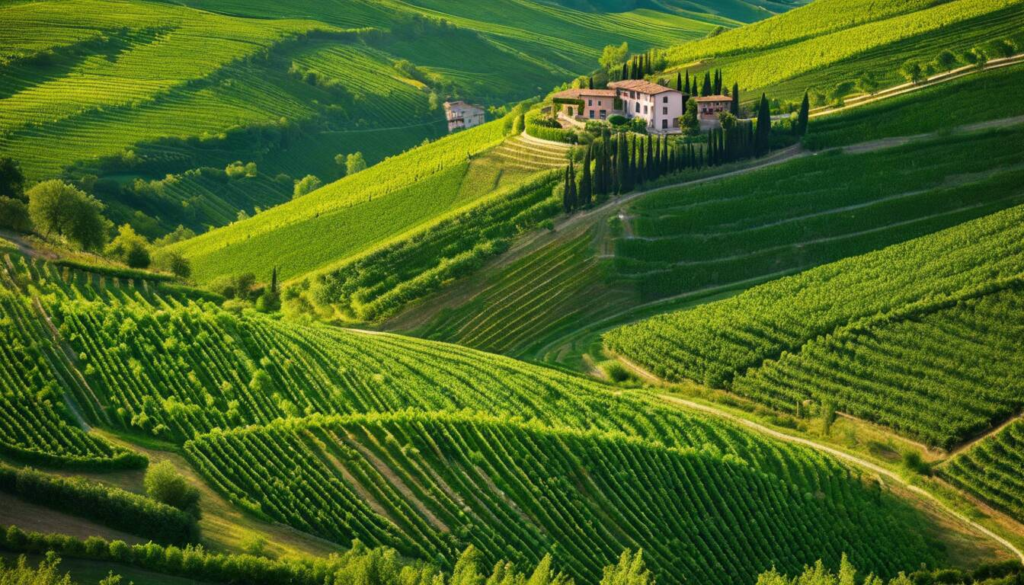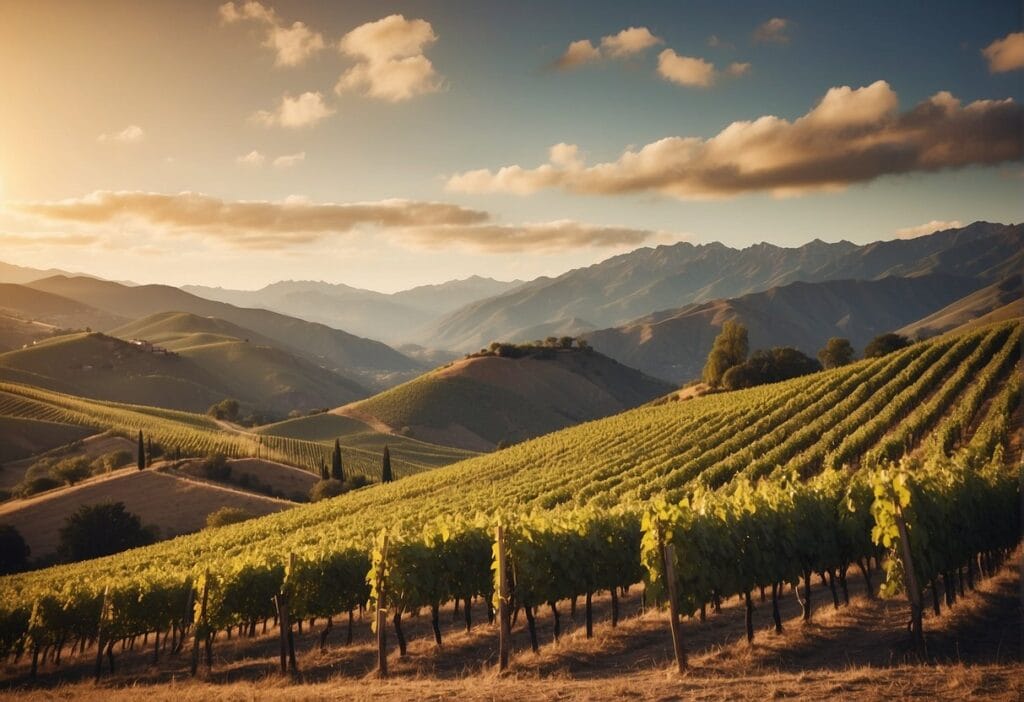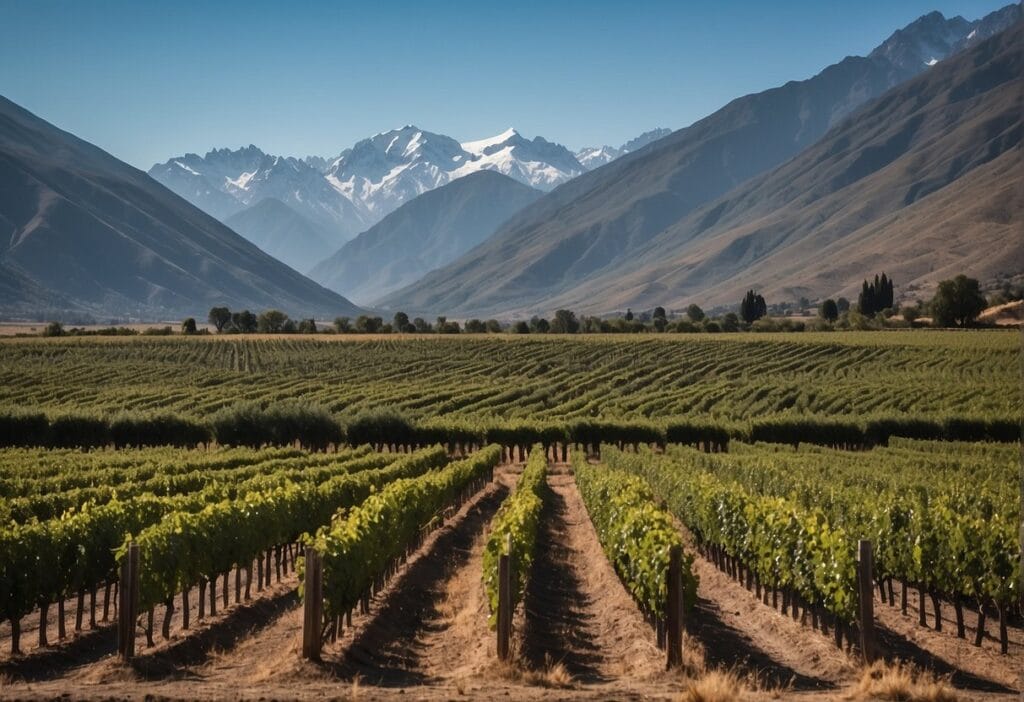Piedmont’s climate and terroir indeed shape the taste of its famous wines. The region, snugly tucked between the Alps and the Mediterranean Sea, experiences varied weather – hot summers and cold winters – perfect for growing different grape varieties. More so, Piedmont’s unique terroir – a fusion of well-drained soils, fluctuating temperatures, and ideal sunlight exposure – lends an unparalleled character to its wines. A sip will reveal this truth, drawing a clear picture of the wine’s identity that is intricately tied to its birthplace. Let’s take a journey to this northwestern corner of Italy.
The climate in Piedmont is characterized by hot, dry summers and cold, foggy winters, providing ideal conditions for grape cultivation. The region’s diverse terroir, influenced by its hilly landscape and variegated soils, contributes to the production of renowned wines such as Barolo and Barbaresco, known for their distinctive flavors and aging potential.

Overview of Piedmont’s Climate
Piedmont, renowned for its world-class wine production, is nestled in the northwest region of Italy. Here, the climate plays a pivotal role, akin to a character in a play – setting the stage for everything that unfolds. It’s not just about the temperature; it encompasses the amount of rainfall, the intensity of the hottest days, and the severity of the coldest nights.
Piedmont’s local climate benefits from an extra layer of diversity due to its proximity to two major landmarks: the Alps and the Mediterranean Sea. The Alps shield the region from cold winds from the north, creating a warm cocoon during winter. Conversely, the nearby Mediterranean Sea exerts a cooling influence on the region during summer due to its moderating effect.
Climatic Characteristics of Piedmont
Understanding these specific climatic characteristics is crucial in visualizing the intricate dance between nature and viticulture:
| Climatic Characteristics | Description |
|---|---|
| Temperature Variation | Piedmont experiences distinct seasons with hot, dry summers and cold, damp winters. This diversity in climate enriches the complexity and depth of flavors found in Piedmont’s wines. |
| Rainfall | Moderate rainfall throughout the year nurtures vineyards and promotes healthy growth. Consistent water supply ensures optimal conditions for high-quality wine production. |
| Microclimates | Microclimates within Piedmont contribute to a multi-faceted terroir enabling growers to cultivate various grape varieties adapted to specific conditions. Hillside vineyards may experience different temperature fluctuations compared to those in valley locations, providing winemakers a broad palette of environmental nuances. |
By understanding these climatic nuances, one can comprehend why indigenous grape varieties such as Nebbiolo, Barbera, and Dolcetto thrive in this dynamic environment. Each grape variety uniquely responds to these climates by expressing distinct aromas, flavors, and textures in Piedmont’s celebrated wines.
The varied climate dynamics within Piedmont significantly contribute to the diverse wine portfolio offered by this enchanting Italian region. But there’s more to uncover—let’s explore how this local climate intertwines effortlessly with the concept of terroir, shaping each bottle of wine with a story drawn from nature itself.
Piedmont’s Unique Terroir
The term ‘terroir’ is often used in wine conversations, but what does it mean, especially in the context of Piedmont? Well, picture this. It’s like a recipe for wine that’s been passed down through generations. Instead of just listing ingredients and steps to follow, it includes everything from the type of soil the grapes grow in to how much sun they get every day.
Piedmont’s terroir encompasses a complex interplay of climate, soil, and topography – each element leaves its distinctive mark on the character of the wines produced here. Imagine that you’re not just growing grapes; you’re creating an environment where nature can weave its magic and create something truly special.
Soil Composition
The soils in Piedmont are predominantly limestone and clay, with excellent drainage properties that benefit grapevines. Limestone imparts elegance and finesse to the wines while clay provides structure and stability. As a result, Piedmont wines are often characterized by their depth and complexity, reflecting the harmonious balance achieved by these soil types.
The unique characteristics of the region’s terroir contribute to the distinct flavors and qualities of Piedmont wines.
It’s amazing to think about how something as seemingly simple as soil composition can have such a profound impact on the taste and quality of wine. That’s the magic of terroir—nature’s subtle yet unmistakable influence on what ends up in our glasses.
Altitude and Sun Exposure
The vineyards in Piedmont are situated at an altitude range of 200 to 500 meters, allowing for optimal sun exposure and temperature fluctuations. This combination provides grapes with just the right conditions to ripen slowly and develop complex flavors, imparting a sense of elegance and depth to the wines. It’s like crafting a beautiful melody—the interplay between altitude, temperature, and sunlight creates a symphony in each bottle.
Think of it this way: Grapes exposed to more sun tend to produce deep, rich flavors, while those grown at higher altitudes retain more acidity, resulting in a perfect harmony of fruitiness and freshness in the final wine.
Geographical Influences
The geographical diversity within Piedmont further enriches its terroir. The varying aspects and slopes of the land allow for different microclimates to emerge, each influencing grape growth in unique ways. Some regions may receive more rainfall or cooler temperatures, leading to subtle variations in flavor profiles across different areas.
Peering into the intricate layers of Piedmont’s terroir reveals how these factors converge to shape an exceptional wine region—one where every sip tells a story of its distinctive landscape and rich heritage.
Understanding how Piedmont’s unique terroir shapes its wines lays a foundation for exploring another essential aspect—how altitude plays a pivotal role in shaping the region’s wine production.
Role of Altitude in Piedmont’s Wine Production

The vineyards of Piedmont are not just picturesque landscapes; they are meticulously planted at varying altitudes that significantly impact the characteristics of the wines produced. As you ascend through the rolling hills and valleys of this region, you encounter a captivating tapestry of vineyards, each contributing to the diversity and complexity of Piedmont wines. It’s remarkable how something as simple as altitude can exert such a profound influence on the taste and quality of wine.
At higher altitudes, temperatures are cooler, with greater fluctuation between day and night. This environment results in grapes ripening more slowly, leading to increased acidity and pronounced flavor development. Conversely, lower altitude vineyards experience milder temperature differentials, allowing for more rapid grape ripening, resulting in wines with different structural and flavor profiles.
Impact of Altitude on Grape Varieties
Different grape varieties respond differently to varying altitudes. For instance, Nebbiolo, one of Piedmont’s star grapes used in producing Barolo and Barbaresco wines, thrives at higher altitudes due to its susceptibility to late ripening. At these elevations, the extended growing season allows Nebbiolo to develop its signature high acidity and complex flavor profile. On the other hand, Barbera and Dolcetto perform exceptionally well at lower altitudes where the warmer climate aids their ripening process.
Consider the renowned Nervi Conterno Gattinara vineyard located at an elevation of around 350-420 meters above sea level. The high-altitude conditions lead to grapes with significant tannins, vibrant acidity, and distinctive minerality—characteristics highly sought after in Gattinara wines.
Altitude’s Contribution to Wine Diversity
The diverse range of altitudes across Piedmont gives winemakers a unique advantage: the ability to produce a wide spectrum of wines with varying styles and flavor profiles from the same region. This enriches the wine landscape by offering consumers a broad selection and showcasing the profound impact of terroir on wine expression.
As we’ve seen how altitude shapes the flavors and characteristics of Piedmont wines, next we will explore how climate patterns further influence the vintages in this renowned region.
Influence of Climate Patterns on Wine Vintages
The rolling hills of Piedmont are not only a feast for the eyes but also play a pivotal role in determining the quality and character of the region’s wines. The climate patterns here aren’t just about whether it rains or shines; they deeply influence the taste and texture of the wines produced.
Vines are sensitive beings. They need just the right amount of rain, sunshine, and warmth to thrive and produce great grapes. But if any of these elements become excessive or scarce, it can have a domino effect on the quality and style of the wines. Too much rain can dilute the flavors and aromas, while too little can lead to stress on the vines, impacting yield and concentration. Similarly, erratic temperature fluctuations can affect maturation, altering the balance of acids and sugars in the grapes.
Consider a year when there’s an unexpected heatwave during summer in Piedmont. This surge in temperature can cause the grapes to ripen earlier than usual, potentially leading to higher alcohol content in the wines. Conversely, a cooler growing season might result in slower ripening, allowing for more delicate flavors to develop.
So, as you can see, climate patterns are like the conductor directing a symphony. Winemakers need to closely monitor these patterns throughout the growing season to anticipate how each vintage will turn out. By doing so, they can make informed decisions about when to harvest and which vinification techniques to employ based on what nature has presented them with.
Now that we’ve gained an understanding of how climate patterns shape Piedmont’s wine vintages, let’s explore how these intricate natural factors interact with the unique terroir of the region to create distinct wines year after year.
Spotlight on Piedmont’s Indigenous Grapes
Piedmont’s winemaking tradition is deeply intertwined with its indigenous grape varieties, each lending its own special charm to the region’s wines. Among these varieties, Nebbiolo stands out as the most famous, known for producing bold, complex wines rich in character and aging potential. The Barbera grape, on the other hand, offers a different profile, yielding vibrant red wines with brighter acidity and soft tannins. Moving on to Dolcetto, it presents an approachable style with gentle tannins and fruity notes. Lastly, Arneis provides a refreshing twist with its white wine expressions, offering floral aromatics and crisp freshness.
Nebbiolo undoubtedly takes center stage in Piedmont’s red wine production. Its thick skin confers deep color, high tannins, and compelling aromas. These nuanced characteristics make Nebbiolo wines quite age-worthy, allowing them to evolve beautifully over time. As for Barbera, it brings an entirely different dimension to the wine scene in Piedmont. Known for its approachability and versatility, Barbera often presents itself as a delightful everyday red wine that can be enjoyed young or aged for a few years. Dolcetto is another standout, celebrated for its charming fruit-forward nature and food-friendly qualities. Often regarded as a “wine of the people,” it is both approachable and expressive, typically best enjoyed in its youth. Meanwhile, Arneis embodies the bright, refreshing essence of Piedmont’s white wines – think lively citrus notes interwoven with delicate floral undertones.
Diversity in Indigenous Grapes
Piedmont isn’t just branded by one dominant grape; instead, it proudly hosts a vibrant tapestry of indigenous grapes, offering distinct varieties that cater to a broad spectrum of wine enthusiasts.
It’s fascinating how each grape adapted to Piedmont’s terroir and climate has carved out its unique niche within the region’s viticultural landscape, showcasing a captivating array of flavors and aromas that reflect the richness of its heritage. This diversity enriches the wine culture in Piedmont, enabling both local winemakers and global admirers to explore an extensive palette of tastes and experiences.
“Piedmont’s winemaking tradition is deeply intertwined with its indigenous grape varieties, each contributing unique characteristics to the region’s wines.”
In essence, these indigenous grapes are more than just key players in winemaking; they are storytellers of Piedmont’s cultural narrative, weaving an intricate tale of resilience, adaptability, and above all, an unwavering commitment to quality. Their influence resonates through every glass poured from Piedmont’s storied vineyards, offering wine enthusiasts an authentic taste of the region’s distinctive character.
With such a rich foundation laid by these indigenous grapes, let’s now uncover the secrets that lead to the exceptional quality of wines emanating from this revered winemaking region.
Keys to the Quality of Piedmont Wines
Piedmont is a region dedicated to the craft of winemaking. The quality of Piedmont wines isn’t left to chance; it’s meticulously shaped by a combination of factors, all working together to produce those renowned flavors and textures that wine enthusiasts cherish.
One of the most impactful contributors to the exceptional quality of Piedmont wines is the diverse microclimates in the region. From the rolling hills where the grapes grow to the gentle valleys, each land pocket boasts unique conditions that significantly influence the flavor and character of the grapes. The variation in temperature, elevation, and rainfall across these microclimates allows winemakers to produce a wide range of wines, from light and fresh varieties to bold and full-bodied options.
Moreover, the cultivation of indigenous grape varieties plays a significant role in shaping the quality and identity of Piedmont wines. Grapes like Arneis, Cortese, Moscato, Dolcetto, Barbera, and Nebbiolo have adapted over centuries to thrive in this specific terroir, contributing distinctive flavors and aromas emblematic of the region. This deep connection between grape and terroir is what sets Piedmont wines apart and gives them their unique taste.
It’s also worth acknowledging the dedication of Piedmont’s winemakers who harmoniously blend traditional techniques with modern innovations. By carefully stewarding the grapes from vineyard to bottle, these winemakers ensure that every step of production maintains the integrity and nuance found in each varietal. The result? Wines that tell a story with every sip—an ode to tradition with a touch of contemporary finesse.
The careful stewardship practiced by winemakers in Piedmont isn’t just about technique; it’s about respecting and understanding how terroir shapes each grape. By meticulously preserving these ancestral practices, winemakers are able to translate the essence of their land into each bottle—a feat that requires both patience and expertise.
In essence, it’s this intricate interplay between microclimates, indigenous grape varieties, and thoughtful winemaking practices that imbues Piedmont wines with their complexity, structure, and profound sense of place.
The unique characteristics of the region’s terroir undoubtedly contribute to the distinct flavors and qualities of Piedmont wines. It’s a testament to how deeply intertwined nature and human craftsmanship are in producing these exceptional wines.

